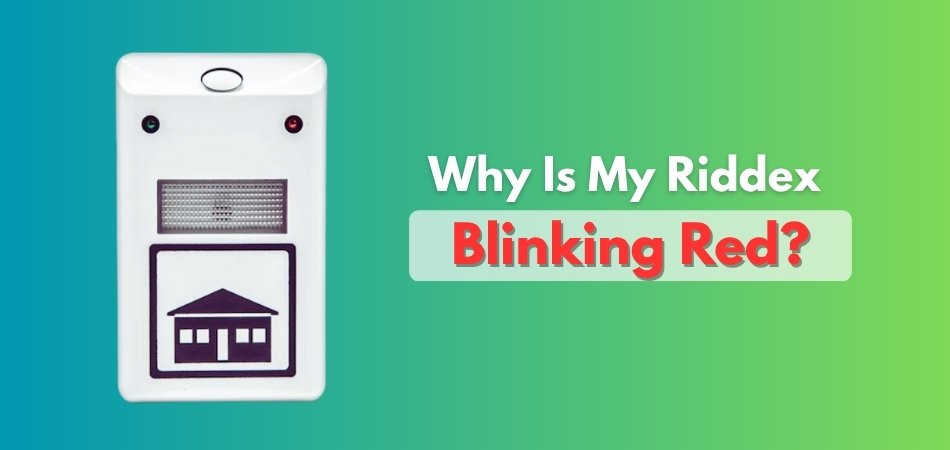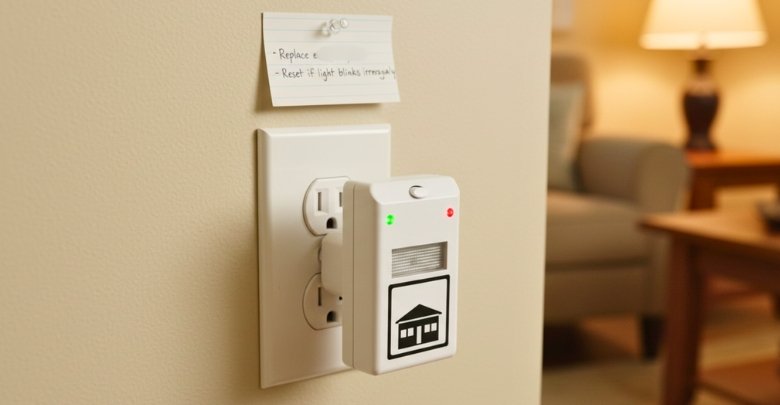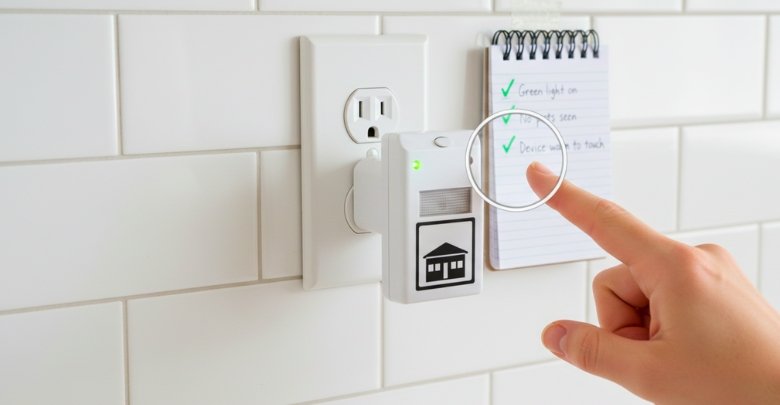Many people get confused when their Riddex suddenly starts blinking red, especially if it has been working quietly for weeks. The small flashing light can make you wonder if something has gone wrong with the device or if it’s signaling a normal function. Understanding it helps remove unnecessary worry.
So, why is my Riddex blinking red? In most cases, the red light indicates that the device is actively working and sending signals to keep pests away. Sometimes, it may also flash because of a slight power fluctuation or internal reset, which is completely normal for electronic devices.
If you’ve ever been unsure about what the blinking really means or when to take action, you’re not alone. Keep reading this article to learn the real reasons behind the red light and how to ensure your Riddex keeps performing efficiently.
Why Is My Riddex Blinking Red?
Many users get alarmed when their Riddex device starts blinking red, assuming it might be faulty. In most cases, the red light simply indicates that the unit is functioning properly and sending signals through your home’s wiring to repel pests. Understanding what this signal means helps prevent unnecessary worry and confusion. Let’s look at how Riddex functions and what each signal actually indicates.

Normal Operation Indicator
A blinking red light can often mean that the Riddex is in its regular working mode. The light blinks periodically to show the device is active and sending signals. If your device is still connected firmly and the green light is also visible, it’s usually working as intended.
Power Supply or Voltage Fluctuation
Sometimes, power instability in your home’s wiring may trigger the red blink. This happens when the voltage drops or the outlet isn’t stable. Performing a quick plug-in test or using a different outlet can often resolve this issue and confirm that the device is receiving enough power.
Loose or Faulty Outlet Connection
A poor electrical connection can also cause the red light to blink irregularly. Ensure that the Riddex is plugged in properly without obstruction. Dust, moisture, or a partially inserted plug might interrupt the power flow, leading to temporary signal changes shown by the red light.
Device Reset or Signal Interruption
Occasionally, the red blinking appears when the device resets itself after a brief power interruption. This is a normal part of the operation cycle and usually stabilizes within minutes. If the blinking continues for a long period, you can unplug it, wait for a few seconds, and reinsert it securely.
Overheating or Internal Adjustment
When used continuously for many hours, the Riddex may adjust its internal sensors to maintain efficiency. During this process, the red light may blink more frequently. This is temporary and should not affect its overall performance or lifespan.
In most cases, a blinking red light does not signal damage but rather active functionality. Based on various Riddex review findings, the light patterns are meant to reassure users that the unit is operating. However, if blinking remains constant without pest control improvement, you may need to inspect the power source or reset the device for better results.
How to Troubleshoot a Constant Red Blink?
A constantly blinking red light on your Riddex can seem frustrating, especially if it doesn’t stop after a while. However, this usually points to a small technical issue that can be fixed easily. Most of these problems are related to power flow, plug connection, or the device’s internal reset process. Follow these simple checks and corrective steps that can help restore your Riddex to normal working condition.
Perform a Plug-In Performance Check
Start with a quick plug-in performance check to confirm the device is receiving stable power. Unplug the Riddex, wait for about 10 seconds, and then plug it back in. Observe whether the blinking slows down or stabilizes. This simple action often resolves minor connection or reset issues.
Try a Different Wall Outlet
Sometimes, the outlet you are using may not provide steady voltage. Plug the Riddex into a different wall socket in another part of the house. If the light stabilizes, it means the first outlet had inconsistent power. This helps you determine whether the issue lies with the device or the power source.
Check for Obstructions or Interference
Large appliances or metal surfaces near the outlet can disrupt signal transmission. Move the Riddex to a more open area, away from refrigerators, microwaves, or heavy wiring. Keeping the device clear of obstructions ensures that the signal flow remains smooth and that the blinking light returns to normal.
Allow the Device to Reset Itself
If the blinking continues, leave the Riddex plugged in for a few hours to allow it to complete an internal reset. Sometimes, the system needs time to realign its signal pattern. Avoid switching outlets too frequently during this process to let the device stabilize properly and resume normal function.
Contact Customer Support if Blinking Persists
Persistent blinking often points to an internal fault or a small component issue. When this happens, reach out to Riddex customer support for help. Share details about the light pattern, outlet used, and how long you’ve had the unit. Their team can guide you through troubleshooting or recommend a replacement.
These simple steps can resolve a constant red blink quickly. Ensuring a clean connection and stable power supply helps the device operate effectively and maintains its pest control performance without interruptions.
When You Should Replace or Reset Your Riddex?
Even with regular maintenance, there may come a time when your Riddex doesn’t perform as effectively as before. Knowing when to reset or replace the device helps keep your pest control efforts consistent. These few simple signs can guide you in deciding the right action to restore its efficiency.

When a Reset Can Solve the Problem
A reset can often resolve minor malfunctions caused by brief power interruptions or unstable voltage. Unplug your Riddex for a few minutes, then plug it back in to allow the system to realign. This quick step helps restart its internal sensors and restore normal blinking or signal transmission.
When Replacement Becomes Necessary
If the red light keeps blinking continuously despite troubleshooting, or if pest activity doesn’t decrease after weeks of use, replacement might be the best choice. Persistent issues can indicate internal wear or signal failure, making the current unit less effective at repelling pests even when plugged in properly.
Average Lifetime of Riddex Device
The average lifespan of Riddex device units typically extends over several years, depending on the environment and frequency of use. Devices exposed to power surges or constant plugging and unplugging may wear out faster. Monitoring light patterns and performance helps you decide when to replace them to ensure continued effectiveness.
Loss of Signal Strength or Effectiveness
Another sign that replacement may be needed is a weak or inconsistent signal transmission. If you notice pests returning even after long-term use, it could mean the internal system is no longer generating a strong enough frequency to repel them effectively. At that stage, a new unit is advisable.
Physical Damage or Burn Marks
Inspect the device occasionally for cracks, burn marks, or discoloration near the plug area. These are signs of electrical strain or overheating. Using a damaged device may reduce its effectiveness and pose safety risks, so replacing it is the safest and most practical solution.
Regular resets and timely replacements keep your Riddex working efficiently for the long term. Staying aware of performance changes ensures your home remains protected from pests without interruption or unnecessary worry.
Comparing Light Indicators: Green, Blue, and Red
The Riddex device uses different light indicators to help users understand its operation status. Each color has a specific purpose, showing whether the device is powered, transmitting signals, or adjusting to electrical conditions. Knowing what these lights mean makes it easier to spot any irregularities and keep your Riddex functioning properly.
Green Light: Power Indicator
The green light confirms that the Riddex device is receiving power and functioning. When it stays steady, it means the unit is on and ready to operate. If this light goes off unexpectedly, it may indicate a power issue or a loose outlet connection that needs to be checked immediately.
Blue Light: Active Signal Transmission
A glowing or blinking blue light typically shows that Riddex is transmitting electromagnetic or ultrasonic signals through your home’s wiring. This light reflects that the pest-repelling process is active. Occasional flickers are normal and confirm that the signal frequency is being adjusted as part of its standard operation.
Red Light: Operation or Power Adjustment
The red light represents the operation cycle or temporary power fluctuation alert. When it blinks periodically, it means the device is actively cycling through its working phase. Constant or rapid blinking may occur during resets or minor voltage changes but usually returns to normal without user intervention.
Interpreting Blinking Patterns
Blinking lights on Riddex are not always warning signs. They often represent internal adjustments that maintain consistent signal strength. Observing how often the lights change can help you identify when the device is operating efficiently or when it might need inspection for stable power and connection.
Recognizing the meaning behind these light indicators helps users avoid unnecessary concern. As long as the lights are cycling as described, your Riddex is operating as intended and providing continuous protection from pests.
How to Know If Your Riddex Is Still Working Properly?
Even after regular use, it’s important to ensure your Riddex is still functioning as intended. Proper verification helps confirm whether the device continues to emit signals and keeps pests away effectively. Doing this occasionally ensures long-term reliability and prevents unnoticed power or signal interruptions. Here are some easy ways to confirm your Riddex is still active and performing properly.

Observe Reduction in Pest Activity
The most noticeable sign that your Riddex is working is a visible drop in pest activity. Over time, rodents or insects should become less common in the area. If you continue seeing pests regularly, it might mean the device needs resetting, repositioning, or checking for power connection issues.
Monitor Light Patterns and Stability
Keep an eye on the indicator lights to confirm the device’s status. A steady green or alternating red blink usually means the Riddex is operating correctly. Irregular or missing lights may signal a power interruption. Consistent light behavior ensures the unit is actively repelling pests within its coverage zone.
Test in Different Power Outlets
If you suspect the device isn’t working, try moving it to another wall outlet. This quick test helps determine whether the problem lies in the outlet or the device itself. If the lights blink normally in a new spot, it confirms that the previous outlet had unstable power.
Perform Occasional Plug-In Performance Tests
Every few weeks, do a simple plug-in test by unplugging and replugging your Riddex. Observe how quickly the lights respond. If they illuminate within seconds, the device is still functional. Slow or no response might indicate internal wear or electrical strain requiring attention or replacement.
Inspect for Dust, Moisture, or Damage
A visual inspection every few months keeps your device in top shape. Look for dust buildup, discoloration, or small cracks around the plug area. Cleaning gently with a dry cloth and keeping it away from moisture prevents performance loss and extends the unit’s lifespan.
Verifying your Riddex’s function from time to time ensures consistent pest protection. With a few simple checks and routine observation, you can maintain your device’s efficiency and enjoy a comfortable, pest-free home environment.
Tips to Keep Your Riddex Working Properly
To make sure your Riddex continues to perform effectively, regular maintenance and proper placement are essential. The device works best when it’s kept in the right environment and given enough space to transmit signals throughout your home. Here are some simple yet important tips to keep your Riddex in top condition and extend its reliable performance for years.
- Place It in a Dry, Central Outlet: Install the Riddex in a dry, open space near the center of your home. This position helps the electromagnetic signals travel evenly across all rooms, improving the overall pest-repelling coverage.
- Avoid Blocking Its Signals: Keep furniture, curtains, or large appliances away from the outlet where Riddex is plugged in. Blocking its signal path may reduce effectiveness and limit how far the device can transmit the repelling waves.
- Clean Dust and Dirt Regularly: Dust buildup around the outlet or on the device surface can interfere with its operation. Wipe the Riddex and the surrounding area occasionally using a dry cloth to maintain strong and uninterrupted performance.
- Do Not Overload Sockets: Avoid plugging Riddex into an outlet already used by high-power appliances like refrigerators or heaters. Overloading can cause voltage drops that affect its performance and may lead to unnecessary blinking or resets.
- Keep It Plugged in Continuously: Unplugging the device frequently disrupts its pest control cycle. Keep your Riddex plugged in at all times for consistent protection, allowing it to maintain steady signal transmission and long-term pest prevention.
Proper care and steady placement ensure your Riddex performs at its best. Following these simple tips keeps your home pest-free and helps the device maintain dependable operation throughout its lifespan.
Frequently Asked Questions
After reading about how Riddex works and how to maintain it, you might still have a few practical questions in mind. Here are some of the most common ones users often ask to better understand the device’s function, usage, and long-term reliability.
Can Riddex Be Used in Any Type of Room?
Yes, Riddex can be used in most rooms, such as kitchens, bedrooms, or offices. However, it works best in open spaces where the signals can travel freely. Avoid using it in damp areas like bathrooms or outdoor spaces for safety reasons.
Does Riddex Work on All Types of Pests?
Riddex mainly targets common household pests like rodents, ants, and cockroaches. It works by disturbing their living environment through electromagnetic or ultrasonic signals. However, it may not be effective against larger pests or insects that don’t respond to sound frequencies.
Can I Use Multiple Riddex Devices in the Same House?
Yes, using more than one Riddex can increase coverage, especially in larger homes. Place them on different floors or areas separated by thick walls. Multiple devices help ensure that the signal reaches every corner where pests might hide.
Is It Safe for Pets and Children?
Riddex is generally safe for both pets and children. The signals it emits are not harmful to humans or household pets like cats and dogs. However, it’s best to keep the device out of reach of small children for safety.
How Long Should I Keep Riddex Plugged in?
For best results, keep Riddex plugged in continuously. Unplugging it too often can disrupt the pest control cycle. Consistent use allows the device to maintain steady signal transmission and keep pests from returning to your home.
Can Power Surges Affect My Riddex Device?
Yes, sudden power surges or voltage drops can temporarily affect its operation. It may cause the lights to blink unusually or trigger an internal reset. Using a surge protector helps keep your Riddex safe and stable during power fluctuations.
Can Riddex Still Work If the Red Light Stops Blinking?
Yes, it can. A non-blinking red light doesn’t always mean the device has stopped working. In some Riddex models, the light may turn steady after completing its initial cycle or internal adjustment. To confirm it’s active, check for a stable green or blue light and ensure the outlet is supplying power properly.
What Should I Do If the Lights Stop Working Completely?
If the lights go off completely, first check the outlet by plugging in another device. If the outlet works, your Riddex may have reached the end of its lifespan. In that case, replacing it is usually the best option.
Concluding Lines
Seeing your Riddex device suddenly blink red can be confusing, especially if you are unsure whether it’s working correctly. The flashing light might seem like a problem at first, but in most cases, it’s simply a sign that the device is active and functioning.
So, why is my Riddex blinking red? The red light usually means the device is running its regular cycle and sending signals through your home’s wiring to keep pests away. At times, it may also blink due to small power fluctuations or an automatic reset, both of which are normal occurrences.
If you’ve noticed this light and want to understand what it truly means, you’re in the right place. Keep reading to learn what the red blinking indicates and how to ensure your Riddex continues to perform efficiently.






